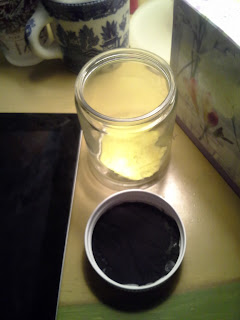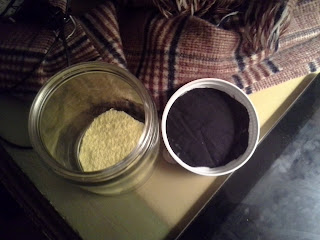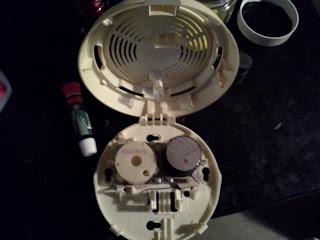I, Hannah Seymour, affirm that I completed my independent component which represents 30 hours of work.
I first learned about cloud chambers from Caltech physicist Sean Carroll. He also taught me how to extract the tiny radioactive americium-241 disk from an ionizing smoke detector. For the experiment procedure I used this website: http://www.bizarrelabs.com/cloud.htm.
A cloud chamber is a very basic particle detector. To build a simple cloud chamber, you need a see-through container (I used a glass jar for science labs involving poisonous materials, as I was sure it would be radiation-safe,) very pure alcohol (I used 91% isopropyl rubbing alcohol,) a piece of blotter paper or sponge, a piece of black cloth, a block of dry ice, and a small radioactive piece. In this case, I used Fiestaware which contains uranium, and the americium from a smoke detector (if you want to try this, please use a broken smoke detector like I did.)
The cloth is glued to the bottom of the lid and the sponge is soaked in the alcohol. The radioactive source is placed in the lid and the jar is screwed upside-down onto it. Then the jar has to sit for 10-15 minutes or so. After that, the jar is placed lid-down onto the dry ice so the alcohol can saturate the jar and vaporize. After 15-20 minutes, when the jar becomes very cold, particle trails will begin to appear. A mist also forms and sinks to the bottom of the jar. Alpha particles leave heavy, dense trails and beta particles leave thin, wispy trails. This works because when a charged particle enters the chamber (from the radioactive source) it ionizes the vapor and produces a mist. There are so many ions produced around these relatively high-energy particles that when the vapor around them condenses a trail is left.
The cloud chamber was one of the very first particle detectors and was used to discover muons and kaons among others. However, interestingly enough, today's high-tech dark matter searches actually utilize many of the same principles that the old-school cloud chamber does. For example, a popular type of experiment uses extremely pure, extremely cold germanium atoms in a controlled environment sealed off from the outside world, sometimes buried deep within an old abandoned mine. Theoretically, a dark matter WIMP (Weakly Interacting Massive Particle) should hit these supercool germanium atoms, which are very still, and leave a trail in the form of it's interaction with the germanium by causing it to "move," in a sense.
Supersymmetric particles are excellent candidates for WIMPs, and I believe the best way for them to be detected is through a dark-matter detection experiment like the germanium one. And if they are found in this way, we are well on the road to solving two of the most elusive problems in physics-dark matter and the existence and nature of supersymmetric particles. From this, I have the third answer to my essential question, "Why is finding supersymmetric particles an important task for physicists to undertake?" "Because supersymmetric neutralinos provide the most accurate candidate for Cold Dark Matter."
Cutting the sponge-diameter 6.5 cm
Sponge layer
Completed parts-notice new lid
Set-up at school
The Geiger counter goes nuts around these two
Fiestaware-don't handle with your bare hands!
Letting sit-right before I put it on the dry ice
Broken smoke detector
I had to take this apart wearing gloves
The americium is the tiny, tiny button resting on the center disk
Letting it sit before it goes on dry ice












